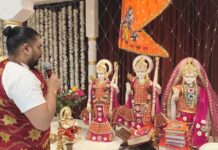
In the last article (There is no real happiness in the world), you learned that the happiness of the world is not a fact, but is only a feeling of the mind, based on the intensity of the desire for a particular person or object. In other words, the greater the desire is for the object, the greater the happiness experienced.
Desire for a person or an object corresponds to the degree of attachment for it in the mind. And attachment grows out of repeatedly thinking of a person or object as a source (or potential source) of happiness (chapter 2, shlok 62). Thus, the mind creates its own experience of happiness through its own thinking – positive hopeful thoughts about a person or thing create an attachment in the mind for that person or thing; and because of the subsequent attachment, the mind feels desire for that person or thing in the same amount; when the mind enjoys the association of that person or thing, happiness is felt in the mind in the same amount.
Such happiness is fleeting, because as you go on enjoying, your desire goes on decreasing, until it finishes altogether. Thus, your happiness also decreases and ultimately finishes. Then you feel neutral or bored and want to find a new object of enjoyment. This is why we say that the happiness of the world is not real happiness. Then the question is – is the world only full of pain?
If there is no happiness in the world, then is it full of pain?
The answer can be understood through the very same philosophy. If the world were truly the form of pain and suffering, then everyone would experience it from the same things, in the same amount, all the time. But this is simply not the case. God realized Saints live in this world and experience only the Divine bliss of God in every particle – then how can we say the world is the source of pain?
Even the rest of us cannot agree on what is a source of pain and suffering. One person suffers if exposed to cigarette smoke, yet another can’t live without it. One person feels happiness when meeting a certain person, yet another can’t stand the sight of them.
The cause of this again comes back to our attachments. Just as the mind creates a positive attachment to a person or thing through repeated positive thinking about them, in the very same way, the mind creates a negative attachment to a person or thing through repeated negative thinking about them.
The positive attachment is called ‘raag’ and the negative attachment is called ‘dvesh’. Both are two sides of the same coin. If you have dvesh for a person or thing, then when you are exposed to or associate with them, you suffer according to the degree of your negative attachment for them.
For example, let’s say a man dies of a sudden heart attack. His wife is so distraught that she faints due to the emotional pain. His son is also in pain, but not enough to lose consciousness – he merely sheds tears. His friend also feels sad, but not enough to cry. His neighbor, who only knew him as a casual acquaintance, doesn’t feel anything. And a rival from work feels happy that he will now be getting a promotion to fill his position.
Now let’s say the man wasn’t truly dead, and he miraculously starts breathing again and awakens. The wife, who had just regained consciousness, faints again, but this time from joy. The son also feels joy, but not enough to faint – he merely sheds tears of joy. The friend is also happy, but not enough to cry. When the neighbor hears the news, he again doesn’t feel anything. And when his rival from work finds out, he is disappointed, because now he is still going to have to take orders from this man.
If we were to ask these people whether this man is a source of happiness or pain, they would all give different answers, depending on their attachment to him. When he was presumed dead, the wife got the most pain from him, because she had the greatest ‘raag’. When you lose something to which you are positively attached, you will feel pain according to the degree of your attachment. The son’s attachment was less, so he felt less pain, and the friend less than that. The neighbor had no attachment (neither raag nor dvesh), so he felt no pain. The rival from work had been humiliated on several occasions by this man who was his manager. Thus, he had developed a strong negative attachment to the man through repeated negative thinking causing him to feel happy upon his death.
When the man awoke, the wife felt the most joy because she had the greatest attachment. The son had less attachment, so he felt less joy and the friend felt even less than that. The neighbor had no attachment (neither raag nor dvesh), so he felt nothing. And the rival who had dvesh for him felt disappointment.
So we see that the very same thing that gives you happiness, also gives you pain when you lose it. This is due to your attachment. There is actually no happiness or unhappiness in the person or object. For the same reason, even the amount of happiness and unhappiness experienced from a thing varies from person to person, depending on their attachments.
Due to all of this, Arjun was not attracted by the incentive of gaining worldly pleasures through fighting the war. However, Shree Krishna also indicated that Arjun could earn entrance to swarg if he performed his dharm by fighting the war. Was this incentive effective in motivating Arjun? We will find out in the next article.
Disciple of Shree Kripaluji Maharaj:
Swami Nikhilanand Ji is a Canadian born Hindu spiritual leader based in Austin, Texas. He is a sanyasi disciple and pracharak of Jagadguru Shree Kripaluji Maharaj.
Attracted to the teachings of Hinduism from a young age, Swamiji eventually let his deep spiritual longing lead him to India, where he was most fortunate to come under the guidance of Shree Kripaluji Maharaj. Thereafter, living in the ashrams of JKP, he extensively studied Hindi, the philosophy of the prime Sanskrit scriptures (Vedas, Darshan Shastras, Gita, Bhagwatam), and practiced meditation in the tradition of raganuga bhakti. In 2003, he was given sanyas.
Now, with the blessings of his Guruji, he offers satsang programs throughout America, engaging audiences with his clear explanations of Hindu philosophy coupled with inspired chanting of Sanskrit mantras and shlokas and charming nam sankirtan. His informative and compelling speeches provide practical insight into how to adopt the teachings of Sanatan Dharm into our daily lives, and inspire us to awaken our inner spiritual potential.
To stay in touch with Swami Nikhilanand Ji, like his Facebook page at https://www.facebook.com/SwamiNikhilanand or follow him on twitter at https://twitter.com/Swami_Nikhil.
Swami Nikhilanand






